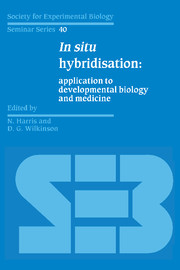Book contents
- Frontmatter
- Contents
- List of contributors
- Preface
- Non-radioisotopic labels for in situ hybridisation histochemistry: a histochemist's view.
- Use of haptenised nucleic acid probes in fluorescent in situ hybridisation
- The use of complementary RNA probes for the identification and localisation of peptide messenger RNA in the diffuse neuroendocrine system
- Contributions of the spatial analysis of gene expression to the study of sea urchin development
- Advantages and limitations of in situ hybridisation as exemplified by the molecular genetic analysis of Drosophila development
- The use of in situ hybridisation to study the localisation of maternal mRNAs during Xenopus oogenesis
- In situ hybridisation in the analysis of genes with potential roles in mouse embryogenesis
- Evolution of algal plastids from eukaryotic endosymbionts
- Localisation of expression of male flower-specific genes from maize by in situ hybridisation
- Tissue preparation techniques for in situ hybridisation studies of storage-protein gene expression during pea seed development
- Investigation of gene expression during plant gametogenesis by in situ hybridisation
- Sexing the human conceptus by in situ hybridisation
- Non-isotopic in situ hybridisation in human pathology
- The demonstration of viral DNA in human tissues by in situ DNA hybridisation
- Index
Tissue preparation techniques for in situ hybridisation studies of storage-protein gene expression during pea seed development
Published online by Cambridge University Press: 04 August 2010
- Frontmatter
- Contents
- List of contributors
- Preface
- Non-radioisotopic labels for in situ hybridisation histochemistry: a histochemist's view.
- Use of haptenised nucleic acid probes in fluorescent in situ hybridisation
- The use of complementary RNA probes for the identification and localisation of peptide messenger RNA in the diffuse neuroendocrine system
- Contributions of the spatial analysis of gene expression to the study of sea urchin development
- Advantages and limitations of in situ hybridisation as exemplified by the molecular genetic analysis of Drosophila development
- The use of in situ hybridisation to study the localisation of maternal mRNAs during Xenopus oogenesis
- In situ hybridisation in the analysis of genes with potential roles in mouse embryogenesis
- Evolution of algal plastids from eukaryotic endosymbionts
- Localisation of expression of male flower-specific genes from maize by in situ hybridisation
- Tissue preparation techniques for in situ hybridisation studies of storage-protein gene expression during pea seed development
- Investigation of gene expression during plant gametogenesis by in situ hybridisation
- Sexing the human conceptus by in situ hybridisation
- Non-isotopic in situ hybridisation in human pathology
- The demonstration of viral DNA in human tissues by in situ DNA hybridisation
- Index
Summary
Introduction
The values of the in situ hybridisation technique, and a background to probes and hybridisation conditions have been discussed elsewhere in this volume. This chapter describes the application of the technique to the study of seed development and considers some different approaches to specimen preparations for histological, cytological and ultrastructural localisation of mRNAs.
Seeds and fruits represent the major food source for humans, and also provide a fascinating range of ‘model’ systems for studying development and differentiation in plant tissues (e.g. reviews Goldberg, 1988; Goldberg et al., 1989). During seed and fruit development, specific genes, such as the storage protein genes, are expressed to high levels and exhibit a substantial degree of temporal and spatial regulation. In developing pea (Pisunt sativum L.) seeds only three multigene families, consisting of approximately 20 genes, give approximately 80% of the total protein synthesis. These genes encode the storage proteins vicilin, a glycosylated 7S, legumin, a non-glycosylated 11S, and con-vicilin, a 7S-type protein.
The general morphological features of the development of dicot seeds are well established, and there have been several detailed reviews of the biochemistry and molecular biology of both embryogenesis (Dure, 1985) and seed storage proteins (e.g. Higgins, 1984; Gatehouse et al., 1986). Seed development progresses in a series of well-defined phases following fertilisation. Initial cell division of the zygote results in a ‘globular’ stage embryo. With subsequent assymetric divisions the cotyledons and plumular apex begin to develop, giving rise to the characteristic ‘heart-shaped’ stage, although there is very little enlargement of cells; the increase in embryo size is a result of the ‘phase of cell division’.
- Type
- Chapter
- Information
- In Situ HybridisationApplication to Developmental Biology and Medicine, pp. 175 - 188Publisher: Cambridge University PressPrint publication year: 1990
- 3
- Cited by



